Effects of Host Hemoglobinopathic Red Blood Cells on the Sensitivity of Plasmodium falciparum to Dihydroartemisinin and Piperaquine
Main Article Content
Abstract
The adaptation of Plasmodium falciparum-infected hemoglobinopathic red blood cells (RBCs) influences the sensitivity of the parasite to antimalarial drugs which may lead to drug resistance. This study aimed to investigate in vitro sensitivity and interaction of P. falciparuminfected RBCs with normal hemoglobin and hemoglobinopathic RBCs, to dihydroartemisinin (DHA) and piperaquine (PIP). Additionally, the effect on PfPI3K enzyme activity via PI(3)P production was also investigated. Twenty-five RBC samples were co-cultured with 3D7 (chloroquine-sensitive) and K1 (chloroquine-resistant) P. falciparum clones. The samples covered several RBC variants including: normal hemoglobin (HbA), Hemoglobin E trait (HbE trait), β-thalassemia trait, α-thalassemia trait, or hemoglobin Constant Spring trait (HbCS trait). Parasite sensitivity to DHA and PIP was investigated using the SYBR green method. PI(3)P production was measured by ELISA. This study showed that 3D7 P. falciparum infected-RBCs with HbE trait and HbA were less sensitive to DHA. On the other hand, the parasite-infected β-thalassemia trait RBCs were the most sensitive to PIP compared to the others. For K1 P. falciparum, a decrease in DHA and PIP sensitivity was found only in the parasite-infected β-thalassemia RBCs. No antimalarial drug interaction was observed between DHA and PIP in either of the P. falciparum strains except for K1-infected α-thalassemia trait RBCs (additive effect). DHA exposure significantly increased PI(3)P expression (>2.5 fold) in 5 3D7 P. falciparuminfected samples, in both normal and hemoglobinopathic RBCs. PIP exposure had no influence on PI(3)P expression. The results suggest that hemoglobinopathic RBCs slightly affect parasite sensitivity to DHA and PIP and PfPI3K activity via PI(3)P production, which may be related to mutation of the PfKelch13 gene and results in artemisinins resistance.
Article Details

This work is licensed under a Creative Commons Attribution-NonCommercial-NoDerivatives 4.0 International License.


